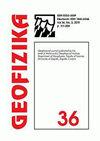Obtaining the Manning roughness with terrestrialremote sensing technique and flood modeling using FLO-2D
IF 1.1
4区 地球科学
Q4 GEOCHEMISTRY & GEOPHYSICS
引用次数: 9
Abstract
Determining the Manning roughness coefficients is one of the most important steps in flood modeling. The roughness coefficients cause differences in flood areas, water levels, and velocities in the process of modeling. This study aims to determine both the Manning roughness coefficient in the river sections and outside of the river regions by using the Cowan method and remote sensing technique in the flood modeling. In the flood modeling, FLO-2D Pro program which can simulate flood propagation in two dimensions was utilized. Mert River in Samsun province located in the northern part of Turkey was chosen as the study area. Samples taken from the river were subjected to sieve analysis, the types of constituent material were determined according to the median diameters and the roughness coefficients were obtained using the Cowan method. For regions outside of the river were applied the maximum likelihood method being one of the controlled classification methods. Manning roughness values were assigned the classified image sections. Remote sensing techniques were meticulously employed to achieve time management in areas outside the river and a new approach was proposed in the Manning assessment of flood areas to ensure uniformity in the study area. In the classification made using the maximum likelihood method, the overall classification accuracy was 92.9% and the kappa ratio “κ” was 90.64%. The results were calibrated with the last hazardous flood images in 2012 and HEC-RAS 2D program, another flood modeling program.利用地表遥感技术获取曼宁粗糙度并利用FLO-2D进行洪水建模
确定曼宁粗糙度系数是洪水建模中最重要的步骤之一。在建模过程中,粗糙度系数会导致洪泛区、水位和流速的差异。本研究旨在利用Cowan方法和遥感技术在洪水建模中确定河段和河区外的曼宁粗糙度系数。在洪水建模中,使用了FLO-2D Pro程序,该程序可以模拟洪水的二维传播。选择土耳其北部萨姆松省的默特河作为研究区域。对从河流中采集的样本进行筛分分析,根据中值直径确定组成材料的类型,并使用Cowan方法获得粗糙度系数。对于河流以外的区域,应用了最大似然法作为受控分类方法之一。曼宁粗糙度值被分配给分类图像部分。精心采用遥感技术来实现河外区域的时间管理,并在洪水区域的曼宁评估中提出了一种新方法,以确保研究区域的一致性。在使用最大似然法进行的分类中,总体分类准确率为92.9%,κ比“κ”为90.64%。使用2012年的最后一次危险洪水图像和另一个洪水建模程序HEC-RAS 2D程序对结果进行了校准。
本文章由计算机程序翻译,如有差异,请以英文原文为准。
求助全文
约1分钟内获得全文
求助全文
来源期刊

Geofizika
地学-地球化学与地球物理
CiteScore
1.60
自引率
0.00%
发文量
17
审稿时长
>12 weeks
期刊介绍:
The Geofizika journal succeeds the Papers series (Radovi), which has been published since 1923 at the Geophysical Institute in Zagreb (current the Department of Geophysics, Faculty of Science, University of Zagreb).
Geofizika publishes contributions dealing with physics of the atmosphere, the sea and the Earth''s interior.
 求助内容:
求助内容: 应助结果提醒方式:
应助结果提醒方式:


